The 2015 MacBook Review
by Ryan Smith on April 14, 2015 10:15 AM ESTThe MacBook’s Retina Display: Pro Quality
One of the long-standing demands for Apple’s MacBook Air line has been for an IPS, Retina-density display for Apple’s light laptops. After introducing Retina-style displays on the MacBook Pro, iPad, iPhone, and iMac, the Air was the last product without a Retina display. However at the same time the Air was also simultaneously Apple’s entry-level laptop and their ultra-portable laptop, so adding a Retina display to the Air has always faced the needs of balancing cost and technical considerations against consumer demand.
As it turns out the Air isn’t getting a Retina display (at least not this year), but Apple is going all-in on the more premium MacBook, Retina display, integrated cover glass, and all. From a cost perspective this isn’t all that surprising, but from a technical perspective it means Apple has needed to address the technical cost of going Retina.
Starting from the top, the MacBook ships with a 12” IPS Retina display. The display’s native resolution is an uncommon 2304 x 1440, which is essentially a 16:10 version of the more common 16:9 1440p. With Apple essentially going pro on the MacBook, I’m happy to see a 16:10 display in what’s now Apple’s smallest notebook, increasing the effective size of the display while giving it a more squared design that increases the amount of vertical real-estate versus what a 16:9 display would offer.
The MacBook’s display ends up being 64.72in^2 in size, roughly 13% larger than the MacBook Air 11”. This comes despite the fact that the MacBook occupies a smaller overall footprint than the MBA 11”, showcasing how Apple has been able to increase the screen size while bringing down the overall laptop size. Some of this is ultimately due to geometry from the different aspect ratio, but also Apple has been able to reduce the size of the bezel surrounding the panel, making the panel a larger percentage of the total lid. The MacBook still isn’t something that most people would qualify as an ultra-thin bezel, but coming from the relatively thick MacBook Air it’s quite the change.
Given the display’s native resolution of 2304 x 1440 contained in a 12” panel, this puts the pixel density of the display at 226 PPI, which is virtually identical to the 226 PPI rMBP13 and 220 PPI rMBP15, giving it same density as Apple’s other Retina laptops. Functionally speaking I’d argue that users are going to have their heads a bit closer to the 12” MacBook than they would a larger rMBP, so the effective density is likely still in the rMBP’s favor, but in terms of construction they’re all very similar.
Meanwhile Apple isn’t going into too much detail on the panel other than its size and driving technology (IPS), but they did tell us that the pixels in this panel were designed to have a wider aperture to allow more light out, helping to offset the higher power costs of lighting a Retina display. To that end Apple says that the MacBook’s display is 30% more energy efficient than any other Mac notebook at an equivalent brightness. At this point we’re still trying to identify the panel supplier, as Apple’s tools have not been very forthcoming. A Sharp IGZO panel would traditionally be a good choice for such a power-constrained device, but it’s entirely possible Apple is going with long-time partner LG as well.
Though regardless of the supplier and aperture improvements, as we’ll see in our battery life benchmarks Apple is clearly still having to devote quite a bit of power towards lighting this screen. Thankfully for Apple however just as with the rMBPs, iPhone, and iPad, this is a one-off cost that they don’t have to pay in future generations.
Moving on, as a Retina display Apple offers a range of scaled (virtual) resolutions, with the MacBook’s default resolution serving as a HiDPI version of 1280 x 800. The fact that the scaled resolution is not exactly one-quarter of the display’s physical resolution is an unusual first for an Apple device, but considering the size of the display and power requirements, not to mention the similar PPIs to the rMBPs, I suspect 1280 x 800 scaled on a 2304 x 1440 display was a tradeoff. In any case even without perfect 2:1 scaling Retina-enabled applications look great, and now nearly 3 years after started on Retina in the OS X ecosystem, the number of applications without Retina support are thankfully miniscule.
As far as desktop performance goes, we haven’t found any major problems for the MacBook’s Intel HD Graphics 5300 GPU. Even with Core M’s power limits it doesn’t show any issues holding 60fps at the default virtual resolution of 1280 x 800, though I would not suggest going any higher unless it’s necessary.
Finally, let’s take a look at the MacBook’s display by the numbers. From a design perspective Apple is shipping a pro-quality display, but does the out of the box performance match up with Apple’s high standards?
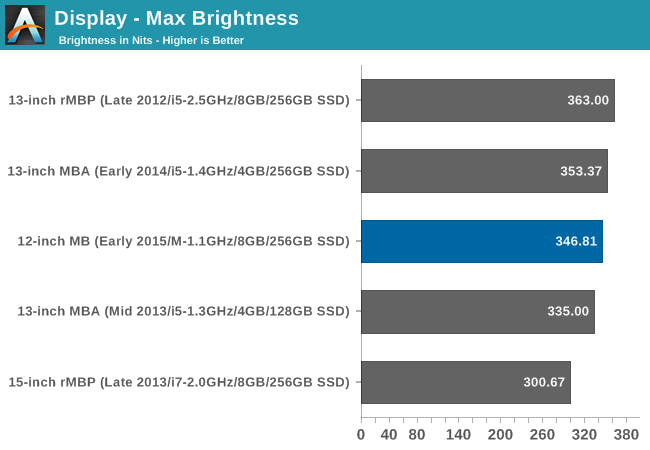
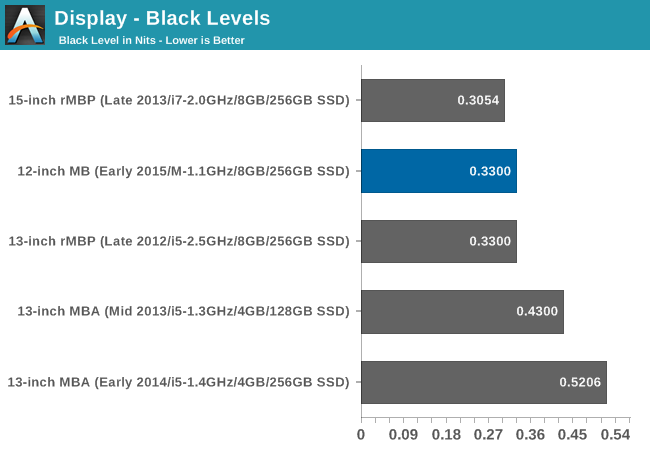
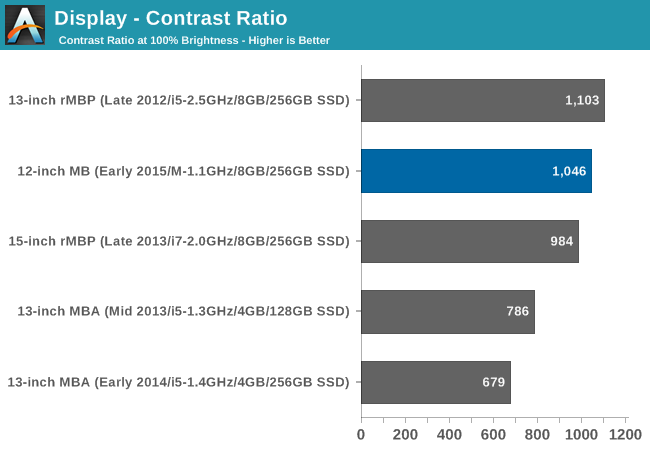
Compared to our most recent MacBooks, the 2015 MacBook delivers contrast performance similar to the Retina MacBook Pros, which is not all that surprising given the shared pixel densities and use of IPS panels among all of these products. Somewhat surprisingly, even with the MacBook’s more limited battery capacity Apple allows the max brightness to go up to 346 nits, in-line with the better-fed rMBPs. At this max brightness setting the black levels work out to 0.33, identical to the 2012 rMBP13. Overall Apple’s black levels tend to be better than average but not fantastic, and the MacBook doesn’t change this.
Otherwise this puts the final contrast ratio at 1046. This is fairly common for HiDPI IPS displays, and though it isn’t chart-topping it’s again right in line with what other Apple laptops do.
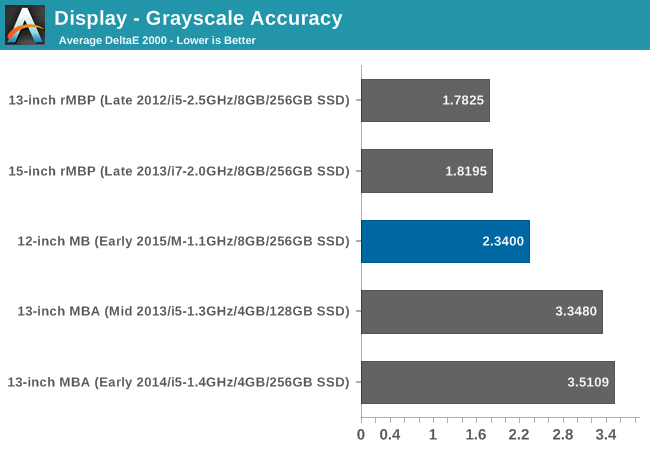
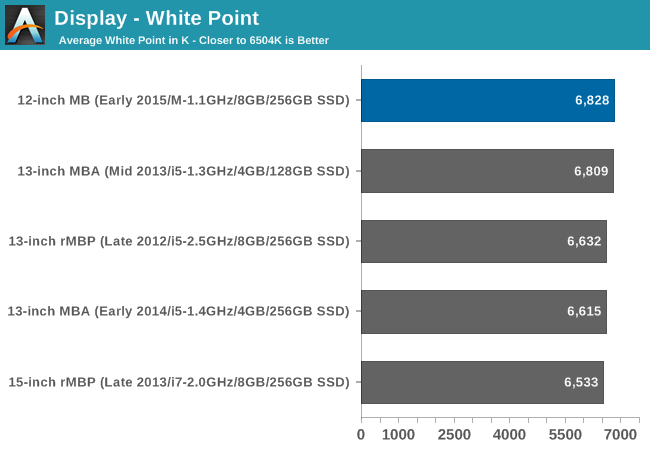
Moving on to accuracy measurements, the MacBook’s greyscale accuracy can’t quite touch the rMBPs, but otherwise at an error of just 2.34 it’s still among the best laptop displays. Even among great PC laptops, out of the box performance below 3 is exceptionally rare.
On the other hand the MacBook’s white point is not quite as good as we’d like to see, and not as good as what the rMBPs can do. The goal here is 6504; the MacBook hits 6828, reflecting the fact that it’s just a bit too red and just a bit too light on blue.
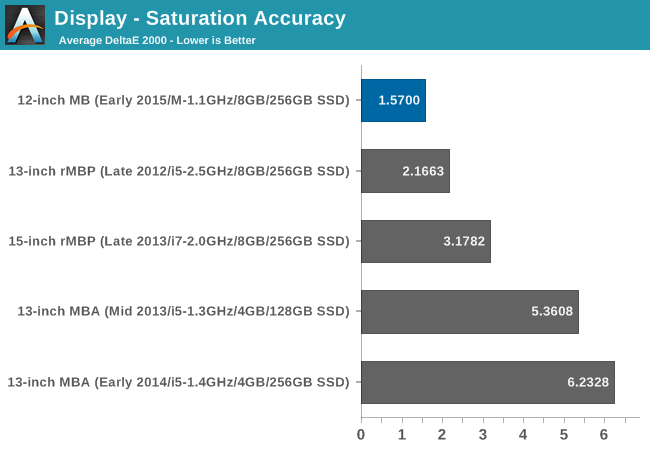
Meanwhile the MacBook’s color saturation accuracy is nothing short of amazing. Here it beats even the rMBPs, not to mention easily surpassing the MBAs and their TN displays. Even though it’s a bit too red, the MacBook is close enough for great out of the box performance.
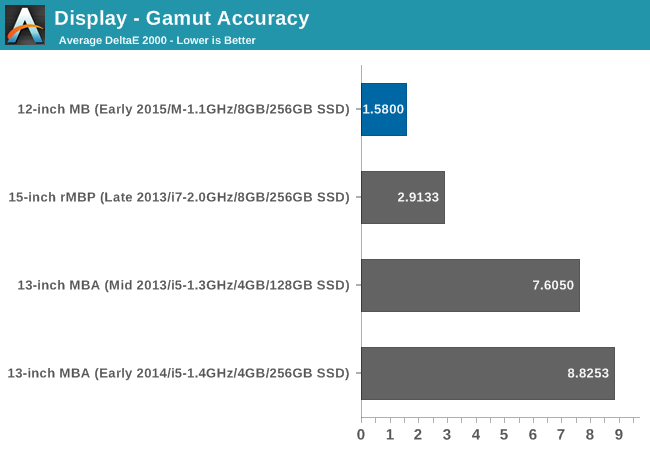
Similar to saturation accuracy, gamut accuracy is well in the MacBook’s favor. Once again even the rMBP we have on file is well behind, never mind the MBAs.
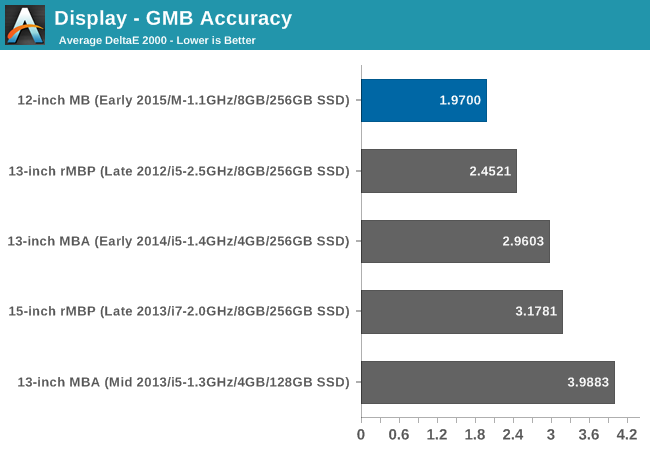
Finally, the GMB color checker results continue to be well in the MacBook’s favor. The error of 1.97 is once more better than any other Mac we have tested, and overall a great place to be at, especially for out of the box performance. Overall this reiterates the fact that while the MacBook may not be classified as a Pro, it without a doubt packs a Pro display.
With post calibration it’s almost certain we could get the errors on the MacBook down to below 1.0. But with such great out of the box performance it’s difficult to complain. Other than for color-critical work, this is a near-perfect reproduction of the sRGB color space.


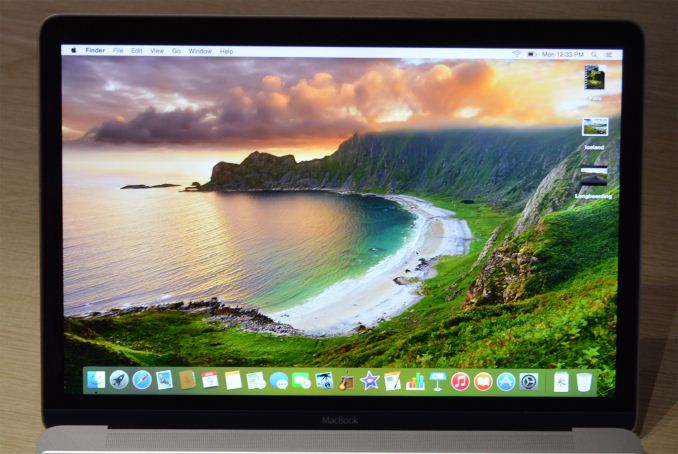
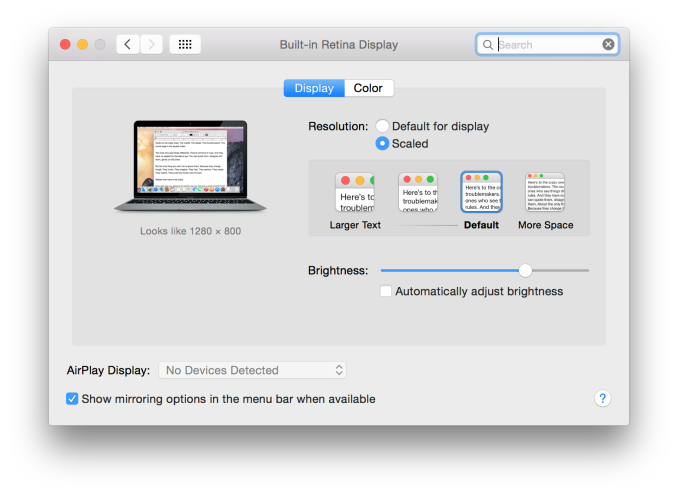
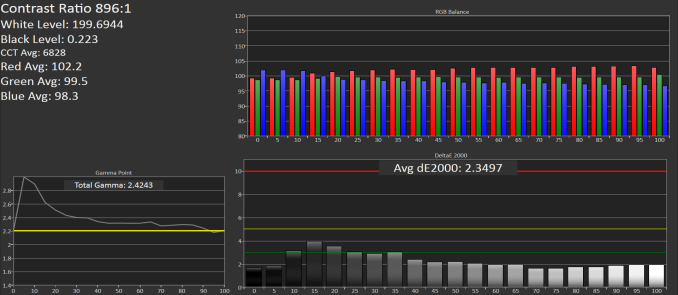
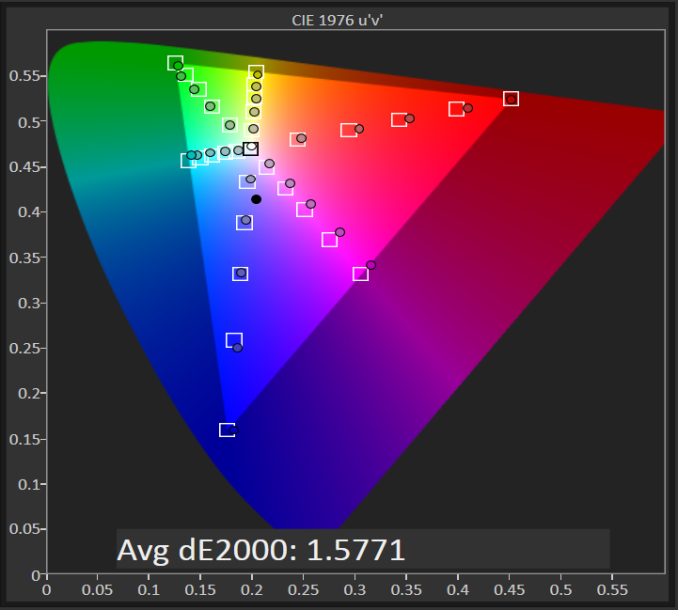










354 Comments
View All Comments
modulusshift - Tuesday, April 14, 2015 - link
Dudebro, Anand's out. He's at Apple now.Ooh, performance over time would have been good.
Definitely with you on the performance per watt and silence, Apple has never been more environmentally friendly.
That said, I don't think this review was bad. Could have used a little more editing, and discussion of the different models as you said. But it had some good material I've yet to see in the rest of the reviews. I wish it lived up to the standard of Anand's review of the SP3 where he gave more of his subjective opinion of how it actually ran. This guy said, yeah, it's thinner and lighter, and I like how it feels, but it's slower than my current 11 inch, so there's a little bit of a tradeoff... And I wonder, why is it slower? Is it actually less capable? What sort of experiences didn't work as you expected? What is really wrong with it?
wave84 - Tuesday, April 14, 2015 - link
The point is I didn't see anything here that I haven't already read on all the other websites all the way from New York Times to the Verge to ArsTechnica. The reason we all visit AnandTech is for those really detailed, in depth 25 page reviews where every single one of our questions gets an answer. Not the case here.The reason why I'm being so determined is that this is a very important review. Like it or not, Apple fanboy or not, the Macbook Air has probably been the most important laptop of the last 10 years. It has basically defined the laptop market of our times and it has been studied, copied and emulated by every manufacturer out there.
Similarly, the new Macbook is probably on a quest to do the same. I would have preferred to wait 2 weeks and read the real thing, not the same article that I've already read 10 times so far (by the way, isn't it strange that all these articles are so similar?)
I'm in a strange boat myself. Started out getting a 2011 13" Macbook Air as a secondary computer, then it slowly transformed into a desktop replacement with an external monitor with the old desktop sold for parts (doing web development, mostly). I would currently kill for the weightlessness / screen / quietness of the Macbook, if the questions above would have been answered. Should I go for the updated 2015 Air? A somewhat bulky Pro? Or maybe just wait for Skylake?
Why have you deserted us, Anand?!... :)
BillBear - Tuesday, April 14, 2015 - link
I don't get the feeling that this would be a viable desktop replacement if you're at all concerned about gaming.lilo777 - Tuesday, April 14, 2015 - link
Hence the term "hybrid". This device is not good either as a desktop replacement or a tablet replacement (or even as a regular laptop replacement). It's a "hybrid" then (probably good for nothing).Ryan Smith - Tuesday, April 14, 2015 - link
Hi Wave, thanks for the feedback. To get right to answering your questions.1) This was the base model, so the $1299 5Y31 model. Apple only samples a single model, so I do not know how the higher end model would fare. However what we've found when looking at other Core M devices is that faster processors can end up throttling sooner, which can be counter-productive. http://www.anandtech.com/show/9117/analyzing-intel...
2) If a load is going to cause the laptop to throttle, it does so almost immediately. As noted in the review, even the 28 second Photoshop benchmark is long enough to require some throttling. As a result pretty much anything longer than a long webpage load is going to face power limits, and longer use will also bring on thermal limits.
Also, while it's not in a chart, I mentioned in the Geekbench 3 section that we ran the stress test. the MacBook reaches equilibrium almost immediately; by the second run it's already down to its steady-state score of 4200.
What this means is that the MacBook can only run at its higher clockspeeds for very, very short periods of time. As a result "performance over time" would be on the order of seconds. This isn't like an Ultrabook or other laptop where performance slowly degrades over time as the cooling system slowly falls behind.
3) Poorly. I wouldn't suggest it. DOTA 2 is about as strenuous as it's going to be able to take. Unfortunately we can't test any of those games as there isn't a suitable FRAPS-like utility for Yosemite to let us do proper benchmarking.
4) The issue with testing efficiency is that to properly test it we need to isolate the CPU and measure it directly. You're not wrong, this is a very efficient processor, but there isn't currently a great way to systematically show that since there's no way to separate the CPU's power consumption from the display's power consumption.
Anyhow, I'm sorry to hear the review didn't live up to your full expectations, but none the less thank you for the feedback and thank you for reading it.
wave84 - Wednesday, April 15, 2015 - link
Thank you for answering all of my questions, Ryan. I withdraw all my complaints :)Kevin G - Wednesday, April 15, 2015 - link
3) I thought Apple's developer tools for OpenGL has a FRAPs-like tool included. I'll have to check when I get home later today.I do know for certain that it has the ability to record VRAM usage over time. Found this out playing around with a GTX 770 and 970 to see just how difficult it was to go over 3.5 GB.
Ryan Smith - Thursday, April 16, 2015 - link
It shows you the frame rate, but it doesn't allow you to record it to find the average frame rate over time.yticolev - Wednesday, April 22, 2015 - link
Hi Ryan, thanks for the excellent review. It supplied details that no other review did. I do have one question that I was hoping would be addressed and that wave84 also asked: buying advice related to Skylake. If what I read is correct, Skylake will be out in just a few months with significant changes to chip architecture promising both better performance and battery life. Better GPU is part of that. It would kill me to purchase now and miss out on an extra hour of battery life with a midyear update.I certainly can wait. I have a perfectly cromulent late 2007 Blackbook that I have not been tempted to upgrade until this new MacBook (which is a huge upgrade to be sure). Now I've got buying fever despite the hassle and expense of upgrading a number of applications that require Rosetta.
One other very minor point, I was surprised you didn't mention iSight as it is a downgrade over other current Apple machines.
modulusshift - Tuesday, April 14, 2015 - link
Replaceable instead of replicable, page 2table instead of cable, DisplayPort instead of DisiplayPort, page 6
could you fix the number for 2010 MBA (last entry) in the 4KB Random Write (8GB LBA, QD3) chart? page 8
tuning instead of turning page 9
On the one hand instead of For one the one hand, second to last page as mentioned by earlier comment.
Thank you for your review.